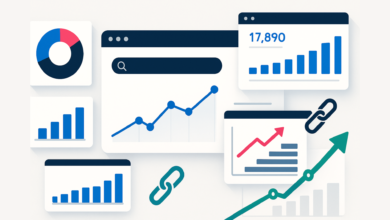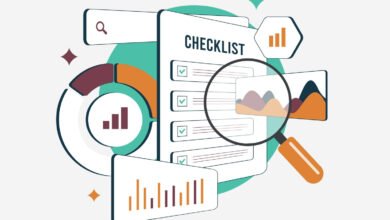The New Age of Search Engine Optimization – A Comprehensive Guide to SEO 2025
- Core Web Vitals and User Experience
- Prioritizing Content for Enhanced Digital Presence
- Keyword Strategy: Beyond the Basics
- Embracing Multimedia for Enhanced Engagement in 2024: Examples and Metrics
- Optimization, Trust, Diversity and AI-Driven Strategies
- Comparison table between Old SEO practices and SEO 2024
▼ Summary
– Mastering SEO in 2025 focuses on creating resonant content, optimizing for emerging technologies, and enhancing user experience, particularly through Google’s Core Web Vitals.
– Core Web Vitals, including Largest Contentful Paint (LCP), First Input Delay (FID), and Cumulative Layout Shift (CLS), are crucial for measuring loading speed, interactivity, and visual stability.
– High-quality, user-centric content is essential, with an emphasis on understanding the audience, engaging storytelling, originality, and regular updates, along with effective multimedia optimization.
– Keyword strategy prioritizes long-tail keywords and understanding user intent, using tools like Google Search Console and SEMrush, and integrating keywords naturally into content.
– Technical SEO emphasizes clean code, structured data, mobile optimization, and building trust through detailed author profiles, with a focus on local SEO, voice search optimization, and leveraging AI and machine learning tools for content analysis and personalization.
Welcome to the definitive guide for mastering SEO in 2025. This year, the focus is on creating content that resonates, optimizing for emerging technologies, and enhancing user experience. This Guide will help you to explore strategies that will pull you up in the continuous changing arena of SEO.
Core Web Vitals and User Experience
Google’s Core Web Vitals are more important than ever, measuring loading speed, interactivity, and visual stability of websites. Great user experience is paramount; ensure your website is easy to navigate, loads quickly, and delivers valuable content.
Think of your website as a cozy café. Just like how the ambiance, speed of service, and layout of a café can make or break a customer’s experience, Google’s Core Web Vitals and overall user experience (UX) do the same for your website. They’re the ingredients for a site that not only ranks well but also delights visitors. Let’s break this down with some everyday examples.
OLD SEO
Keyword stuffing for higher Rankings.
↓
SEO 2025
Write quality content that is useful for the user.
Understanding Core Web Vitals Through Real-Life Scenarios
- Largest Contentful Paint (LCP): Imagine walking into a café and waiting forever for your order to be acknowledged. Similarly, LCP measures how quickly the main content of your webpage loads. A fast LCP is like being greeted promptly as you enter – it’s welcoming and efficient. You can optimize LCP by compressing large images or choosing a better web hosting service, ensuring your website’s main content pops up swiftly like a friendly waiter ready to take your order. To provide a good user experience, strive to have LCP occur within the first 2.5 seconds of the page starting to load.
- First Input Delay (FID): This is like the time it takes for the waiter to respond after you call them over. FID measures the responsiveness of your website when a visitor interacts with it. Minimizing JavaScript or breaking up long tasks can improve FID, making sure your website responds quickly, just like a waiter who’s right there when you need them. To provide a good user experience, strive to have an FID of less than 100 milliseconds.
- Cumulative Layout Shift (CLS): Ever had the experience of sitting down at a café and suddenly having your table jerked away? That’s what CLS feels like when elements on a webpage shift around unexpectedly as it loads. By specifying size attributes for images and reserving space for ads, you can stabilize your page’s layout, ensuring a smooth and unshifting browsing experience – much like enjoying a peaceful coffee without any unexpected table movements. To provide a good user experience, strive to have a CLS score of less than 0.1
Going Beyond Core Web Vitals
While these vitals are crucial, they’re part of a larger picture of user experience. A site that’s easy to navigate with clear menus is like a café with a well-organized menu board – visitors can effortlessly find what they’re looking for. Similarly, a visually appealing and accessible website welcomes everyone, just like a café with comfortable seating and a ramp for wheelchair access.
OLD SEO
User Experience was not a primary consideration.
↓
SEO 2025
User Experience is Crucial for Higher Rankings.
Practical Steps to Enhance User Experience
- Optimize Images: Just as you wouldn’t clutter a café with oversized decorations, don’t let large images slow down your site. Use tools like TinyPNG to compress images without losing quality.
- Simplify JavaScript: Think of JavaScript like the background music in a café. Too loud, and it’s distracting; but at the right level, it enhances the experience. Optimize and minimize JavaScript for a seamless, enjoyable browsing experience.
- Design for Stability: In your website’s design, plan for where each piece of content will sit, just like carefully planning the layout of a café for smooth customer flow.
Measuring and Adjusting: The Continuous Process
Just as a café owner might regularly check on customer satisfaction, use tools like Google’s PageSpeed Insights to keep an eye on how your website is performing in terms of Core Web Vitals and other UX metrics. Regular check-ups help you stay on top of any issues and ensure your site remains a welcoming place for all visitors.
Prioritizing Content for Enhanced Digital Presence
Creating engaging, original content is crucial. Dive deep into topics and mix up your format with videos, graphics, and infographics. Focus on high-quality, in-depth content that addresses user problems and questions. Regularly update your old content to keep it fresh and relevant.
Here’s a straightforward look at how content shapes SEO strategies this year:
The Importance of Content in SEO
Content is the core element of any website. It’s what search engines use to understand and rank pages. High-quality, relevant content is essential for attracting and retaining website visitors, directly influencing search engine rankings.
OLD SEO
Text based Content dominated.
↓
SEO 2025
Multimedia Content is increasingly important.
Key Aspects of Content Creation
Audience Understanding: Knowing your audience is crucial. Content should be tailored to meet their needs and answer their questions. This relevance is what makes content effective in SEO.
Engagement and Storytelling: Content should engage the reader. Whether it’s through blog posts, videos, or infographics, the goal is to keep the audience interested and engaged.
Originality and Depth: Unique and comprehensive content stands out. It should offer new insights or data, going beyond surface-level information.
Regular Updates: Updating content regularly is necessary to keep it relevant and effective. This includes revising old content and adding new information.
Expanding Beyond Text: Diversifying content types is crucial. Videos, podcasts, and infographics can reach different audience segments and cater to varying content consumption preferences.
Content Performance Analysis
Using tools like Google Analytics is essential for tracking content performance. Metrics to monitor include page visits, engagement rates, and user behavior after engaging with the content. This data is crucial for refining SEO strategies.
Keyword Strategy: Beyond the Basics
Long-tail keywords are essential for capturing specific search intents. Use keywords naturally in your titles and throughout your content. Embrace tools like Google Search Console and Semrush for effective keyword research.
OLD SEO
Local businesses needed more visibility.
↓
SEO 2025
Local SEO has gained significance, optimizing for local searches.
Understanding Keyword Relevance and Intent
- Long-Tail Keywords: These are longer, more specific phrases that target niche demographics and specific user intents. They are crucial for attracting a targeted audience and are often less competitive than broader terms.
Example: Instead of targeting a broad keyword like “gardening,” focus on long-tail keywords such as “organic vegetable gardening tips for beginners.” This specific phrase targets a niche audience and caters to their precise search intent. - Search Intent: Understanding why users are searching for specific terms is vital. Keywords should align with user intent, whether informational, navigational, transactional, or investigational. This alignment ensures that the content meets the needs of the searcher.
Example: For a keyword like “best running shoes,” the intent might be transactional (looking to buy) or informational (seeking reviews). Creating content that addresses both intents, such as a blog post titled “10 Best Running Shoes in 2025: Reviews and Buyer’s Guide,” can effectively meet this varied user intent.
Advanced Keyword Research Techniques
- Competitive Analysis: Investigate the keywords competitors are ranking for to identify gaps and opportunities in your own strategy. Example: If a competitor ranks well for “gluten-free baking recipes,” but lacks content on “gluten-free baking recipes for kids,” there’s an opportunity to fill that gap in your content.
- Use of Keyword Research Tools: Utilize advanced tools like Google Search Console, Ahrefs, and SEMrush for deeper insights into keyword trends, search volumes, and competition levels.
- Semantic Search and Related Keywords: Focus on semantic search, which involves understanding the context and user intent behind search queries. Use related keywords and synonyms to broaden the scope of content relevance. Example: For a primary keyword like “yoga classes,” include related terms like “beginner yoga tips,” “yoga for flexibility,” and “home yoga practice” to cover a broader scope related to the primary keyword.
Integrating Keywords into Content
- Strategic Placement: Keywords should be strategically placed in title tags, meta descriptions, headers, and throughout the body content. The placement should feel natural and not forced.
- Balancing Keyword Density: Avoid keyword stuffing. Maintain a natural flow of language while ensuring that the primary and secondary keywords are adequately represented.

Monitoring and Adapting Keyword Strategies
- Performance Tracking: Regularly monitor keyword performance using tools like Google Analytics. Pay attention to changes in search rankings, traffic, and engagement metrics.
- Adaptability: Be prepared to adapt your keyword strategy based on performance data and evolving search trends. This adaptability is crucial for staying relevant and competitive in the search landscape. Example: If new search trends emerge, such as “eco-friendly skincare,” quickly incorporate these terms into your content to stay relevant and competitive.
Embracing Multimedia for Enhanced Engagement in 2025: Examples and Metrics
In 2025, incorporating multimedia into SEO strategies is crucial for attracting and retaining user interest. Here’s a practical approach with examples and recommended metric benchmarks to optimize multimedia for better engagement and SEO performance.
OLD SEO
Easier to manipulate SEO with Blackhat techniques.
↓
SEO 2025
Frequent updates (Reviews, HCU, BERT) prioritatize UX and penalize low-quality content.
Role of Multimedia in Engagement
- Example: For a blog on “Indoor Gardening Tips,” include high-resolution images of various indoor plants.
- Recommended Rate: At least one relevant image per content section or every 300-500 words.
- Videos:
- Example: On a cooking website, embed a short video demonstrating a recipe.
- Recommended Rate: One video per major topic or product showcased, keeping duration around 2-5 minutes for optimal engagement.
- Infographics:
- Example: In an article about “The Impact of Recycling,” use an infographic to visually represent statistics and processes.
- Recommended Rate: One infographic for every long-form article (over 1000 words).
Best Practices for Multimedia Optimization
- Alt Text and Descriptions:
- Example: For an image of a yoga pose, use alt text like “Advanced Yoga Pose Demonstration.”
- Recommended Practice: Every image and video should have descriptive, keyword-inclusive alt text and descriptions.
- File Size and Format:
- Example: Compress a high-quality image from 3MB to under 200KB using image compression tools.
- Recommended File Size: Keep images under 200KB and videos optimized for web streaming.
- Example: Use CSS media queries to ensure that videos and images adapt to different screen sizes, especially for mobile viewing.
- Recommended Practice: Test multimedia elements across various devices for consistent user experience.
OLD SEO
Get as many Backlinks as possible.
↓
SEO 2025
Focus on Authoritstive Backlinks.
Metrics for Measuring Multimedia Engagement
- Bounce Rate:
- Target Benchmark: Aim for a bounce rate lower than 40%. A lower bounce rate indicates users are engaging more with the content and exploring further on the website.
- Strategies to Improve: Improve content quality, optimize website design, ensure swift loading times, and use pop-ups sparingly.
- Dwell Time:
- Target Benchmark: Longer dwell times are generally better, with an aim of several minutes depending on the content length and type.
- Strategies to Improve: Create high-quality, engaging content, including in-depth blog posts, videos, infographics, and ensure easy navigation.
- Pages Per Session:
- Target Benchmark: Aim for an average of 2.2 pages per session or higher. This indicates that users are interested in exploring more content on your site.
- Strategies to Improve: Implement an interlinking system, create catchy headlines, and engage users through the comment section to encourage further reading.
- Click-Through Rates (CTRs):
- Target Benchmark: For SEO, aim for an average CTR of 9.8% for first-page results. Higher CTRs suggest that your content is relevant and useful to users.
- Strategies to Improve: Ensure that your titles and meta descriptions are compelling and accurately reflect the content, and optimize for featured snippets where possible.
OLD SEO
Focus on Blog posts only.
↓
SEO 2025
Repurpose 1 post across newsletter, videos and social media.
Optimization, Trust, Diversity and AI-Driven Strategies
Technical SEO: The Backbone of Your Website
Don’t overlook the technical aspects of SEO. Focus on clean code, structured data markup, and a secure site with SSL certificates. Ensure your website is optimized for mobile devices, as mobile usage continues to dominate internet access.
Building Trust with Author Entities
In an era of AI-generated content, showing that real humans are behind your content is crucial. Create detailed author profiles and showcase their expertise across platforms. This human touch builds trust and authority with both users and search engines.
Diversifying Beyond Google
While Google remains dominant, other platforms like TikTok, Instagram, and Amazon are becoming significant search destinations. Understand where your audience is searching and optimize your content for these platforms as well.
Local SEO and Voice Search: Claim Your Space
If you have a physical presence, optimize your Google My Business profile and create localized content. With the rise of voice search, optimize your content for natural language queries to cater to this growing trend.
AI and Machine Learning: Your SEO Superpowers
Leverage AI and machine learning tools for content analysis, tracking industry trends, and personalizing user experiences. These technologies can provide valuable insights and help tailor your SEO strategy.
Measuring Success and Adapting Strategies
SEO is an ongoing process. Use analytics tools like Google Search Console to track your progress and adapt your strategy based on data. Regular SEO audits are essential for staying ahead.
Comparison table between Old SEO practices and SEO 2025
| Aspect | Old SEO | SEO 2025 |
|---|---|---|
| Keyword Focus | Heavy emphasis on exact-match keywords | Contextual and semantic keyword relevance |
| Content Quality | Quantity over quality | High-quality, valuable content is prioritized |
| Link Building | Quantity of backlinks mattered | Quality and relevance of backlinks matter |
| User Experience | Secondary consideration | Primary focus, including mobile optimization |
| Algorithm Adaptation | Slow response to algorithm changes | Agile and proactive adaptation to algorithms |
| SEO Techniques | Traditional methods like keyword stuffing | Advanced techniques like AI-driven analysis |
| Local SEO | Basic or negligible focus | Highly tailored local SEO strategies |
| Search Intent | Less focus on user intent | Deep focus on meeting user search intent |
| Voice Search Optimization | Rarely considered | Essential component of SEO strategy |
| AI and Automation | Limited use | Extensive use in strategy and analysis |
| Content Length | Fixed content length favored | Variable content length based on relevance |
| Multimedia Integration | Basic use of images and videos | Rich multimedia integration for engagement |
| Mobile Optimization | Often overlooked | Essential due to mobile-first indexing |
| Technical SEO | Basic implementation | Complex and critical for performance |
| User Data Privacy | Less emphasized | Highly prioritized with GDPR, etc. |
| Social Media Integration | Seen as separate from SEO | Integrated into overall SEO strategy |
| Analytics and Reporting | Standard reporting | Advanced, real-time analytics used |
SEO in 2025 is about being adaptable, human-centric, and data-driven. By focusing on user experience, quality content, technical optimization, and leveraging new technologies, you can achieve sustainable success in search engine rankings. Now, equipped with these strategies, go forth and conquer the SEO landscape!





One Comment